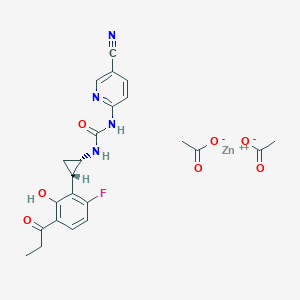







1. Carrageenin
2. Iota Carrageenan
3. Iota-carrageenan
4. Kappa Carrageenan
5. Kappa-carrageenan
6. Lambda Carrageenan
7. Lambda-carrageenan
1. 9000-07-1
2. Zinc;1-(5-cyanopyridin-2-yl)-3-[(1s,2s)-2-(6-fluoro-2-hydroxy-3-propanoylphenyl)cyclopropyl]urea;diacetate
3. Carrageenan, Native
4. Miv-150/za/cg
5. Miv-150/zinc Acetate Carrageenan
6. Zinc 1-(5-cyano-2-pyridyl)-3-[(1s,2s)-2-(6-fluoro-2-hydroxy-3-propanoyl-phenyl)cyclopropyl]urea Diacetate
1. Kappa-carrageenan
2. Carrageenan Api
| Molecular Weight | 551.8 g/mol |
|---|---|
| Molecular Formula | C23H23FN4O7Zn |
| Hydrogen Bond Donor Count | 3 |
| Hydrogen Bond Acceptor Count | 10 |
| Rotatable Bond Count | 5 |
| Exact Mass | 550.084219 g/mol |
| Monoisotopic Mass | 550.084219 g/mol |
| Topological Polar Surface Area | 195 Ų |
| Heavy Atom Count | 36 |
| Formal Charge | 0 |
| Complexity | 647 |
| Isotope Atom Count | 0 |
| Defined Atom Stereocenter Count | 2 |
| Undefined Atom Stereocenter Count | 0 |
| Defined Bond Stereocenter Count | 0 |
| Undefined Bond Stereocenter Count | 0 |
| Covalently Bonded Unit Count | 4 |
Traditional Medicine: ... Used in tuberculosis, coughs, bronchitis, and intestinal problems, usually in the form of a decoction of the seaweed.
Leung, A.Y., Foster, S. Encyclopedia of Common Natural Ingredients Used in Food, Drugs, and Cosmetics. New York, NY. John Wiley & Sons, Inc. 1996., p. 126
Carrageenan, both in the degraded (molecular weight greater than or equal to 20,000) and undegraded forms, has been reported to alleviate peptic and duodenal ulcers in humans.
Leung, A.Y., Foster, S. Encyclopedia of Common Natural Ingredients Used in Food, Drugs, and Cosmetics. New York, NY. John Wiley & Sons, Inc. 1996., p. 125
IN GUINEA-PIGS, NATIVE FORM OF CARRAGEENAN WAS NOT ABSORBED; DEGRADED CARRAGEENAN COULD NOT BE DETECTED IN URINE OF ANIMALS @ LEVELS OF ABOUT 0.3 MG/ML AFTER 1.85 G HAD BEEN ADMIN IN DRINKING-WATER OR @ LEVELS OF BETWEEN 0.03-0.3 MG/ML WHEN 4-15 MG/KG BODY WT OF DEGRADED CARRAGEENAN HAD BEEN ADMIN IV.
IARC. Monographs on the Evaluation of the Carcinogenic Risk of Chemicals to Humans. Geneva: World Health Organization, International Agency for Research on Cancer, 1972-PRESENT. (Multivolume work). Available at: https://monographs.iarc.fr/ENG/Classification/index.php, p. V10 186 (1976)
NATIVE CARRAGEENAN FED TO YOUNG RATS @ LEVELS OF 2-20% IN DIET WAS FOUND TO BE EXCRETED QUANTITATIVELY IN FECES.
IARC. Monographs on the Evaluation of the Carcinogenic Risk of Chemicals to Humans. Geneva: World Health Organization, International Agency for Research on Cancer, 1972-PRESENT. (Multivolume work). Available at: https://monographs.iarc.fr/ENG/Classification/index.php, p. V10 186 (1976)
NO STORAGE OF CARRAGEENAN WAS FOUND IN RHESUS MONKEYS GIVEN 1% NATIVE CARRAGEENAN IN DRINKING-WATER OVER 7-11 WEEKS, FOLLOWED BY 24-WK RECOVERY PERIOD. IN CONTRAST, DEGRADED CARRAGEENAN, WHICH WAS RETAINED AFTER ABSORPTION IN RETICULOENDOTHELIAL TISSUE, COULD STILL BE FOUND IN KUPFFER CELLS 6 MONTHS AFTER ADMIN.
IARC. Monographs on the Evaluation of the Carcinogenic Risk of Chemicals to Humans. Geneva: World Health Organization, International Agency for Research on Cancer, 1972-PRESENT. (Multivolume work). Available at: https://monographs.iarc.fr/ENG/Classification/index.php, p. V10 186 (1976)
Carrageen has inhibitory effects on pepsin activity in vitro. Its degraded form (no viscosity) and forms with low and high viscosities all exhibit antiproteolytic activities in vitro against papain.
Leung, A.Y., Foster, S. Encyclopedia of Common Natural Ingredients Used in Food, Drugs, and Cosmetics. New York, NY. John Wiley & Sons, Inc. 1996., p. 125
